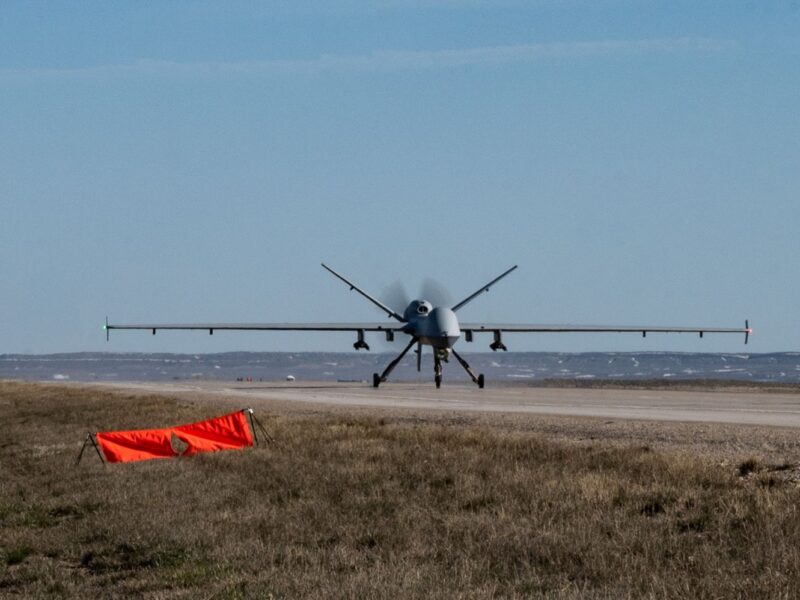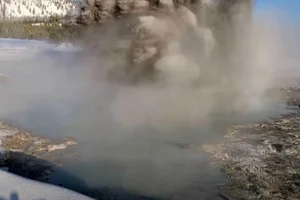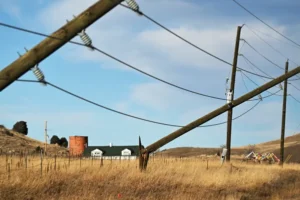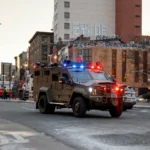U.S. Air Force Makes History Landing Drone on Wyoming Highway
“Exercise Agile Chariot” used roads in Rawlings and Riverton to test the agility of its aircraft
- Published In: Other News & Features
- Last Updated: May 06, 2023

An MQ-9 Reaper lands on Highway 287 near Rawlins during Exercise Agile Chariot on April 30. The landing marked the first time an unmanned aircraft, piloted remotely, had successfully completed a highway mission. (U.S. Air Force photo by Tech. Sgt. Carly Kavish)
By K.L. McQuaid
Special to the Wyoming Truth
The U.S. Air Force made military history on a Wyoming highway this week, when it landed an unmanned aircraft on a stretch of rural road near Rawlins.
The MQ9 Reaper drone was one of several airplanes and helicopters that the Air Force deployed on April 30 and May 2 to test the agility of its aircraft and prepare for non-conventional takeoffs and landings if airports or carriers aren’t available.
In addition to highways 287 and 789 in Rawlins, “Exercise Agile Chariot” also used a roadway about 10 miles south of Riverton as a runway and landing strip.

“It’s just such an incredible place, and we had a lot of support from Wyoming,” said Major Matt Waggy, the Mission Commander for Agile Chariot and the Director of Operations for the 15th Special Operations Squadron, which is based in Florida.
To land a MC-130J Commando II plane – at 160,000 pounds and with a wingspan of 132 feet one of the largest airplanes in the entire U.S. military’s fleet – the Air Force received permission from the state to cordon off over 5.5 miles of highway.
“At 30,000 feet in length, we had one of the world’s largest runways,” Waggy told the Wyoming Truth. “We probably didn’t need 30,000 feet for the exercise, but it was useful because we were in an area with no power lines, no obstacles.”
“And it helped that the road was solid,” he added. “Let me tell you, they know how to build some roads in Wyoming.”

During the first day of the exercise, Gov. Mark Gordon flew aboard the hulking MC-130J airplane. Gordon’s office did not respond to an email request for comment regarding the operation.
In all, 13 different state and federal agencies – from the Wyoming Department of Transportation to the National Forest Service – came together to help the Air Force with the unorthodox training.
“We’re very happy to say that both days were executed flawlessly,” Waggy said.
The exercise built on a similar operation near Rawlins in 2021, when the Air Force landed C-130 aircraft on the roadways for similar training.
This time around, in addition to the landings and take-offs, the Air Force practiced on-site re-fueling, arming, combat turnarounds and search-and-rescue simulations.
It also deployed a greater number of aircraft, including A-10 Thunderbolt II attack planes and MH-6M Little Bird helicopters.
Hundreds of active duty, reserves and National Guardsmen also participated in the drills.

Despite the numbers, though, speed was critical. The Air Force was limited to just four-hour blocks to conduct its training to keep vehicular traffic going. Waggy said they completed their work in about three hours both days.
“Our goal was to build on what we’d done previously,” Waggy said. “Landing on a highway is not new – it happens in Europe with some frequency, for instance. But we built on that, and we did it organically.”
In the case of the unmanned MQ-9 Reaper, the craft was operated remotely by pilots in Florida, Waggy said.
“What the military was doing there was thinking ahead,” Waggy said. “We don’t know from where we might have to operate from in the future. So these were both pro-active and re-active maneuvers, increasing the survivability of our troops through the projection of power.”
Waggy said similar future drills will likely occur to keep crews combat ready, though he declined to say if they would be held again in Wyoming.
“This won’t be the last exercise people will see,” he said. “The future is to be determined. But we have momentum now, and we’ve shown new capabilities. Wyoming has certainly set the standard for all future exercises.”













